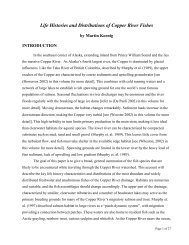Mitigation for the Construction and Operation of Libby Dam
Mitigation for the Construction and Operation of Libby Dam
Mitigation for the Construction and Operation of Libby Dam
You also want an ePaper? Increase the reach of your titles
YUMPU automatically turns print PDFs into web optimized ePapers that Google loves.
Keeler Creek<br />
Bull trout that spawn in Keeler Creek (including <strong>the</strong> North, South <strong>and</strong> West Forks)<br />
are an adfluvial stock, that migrate downstream out <strong>of</strong> Bull Lake into Lake Creek, <strong>the</strong>n up<br />
Keeler Creek. This downstream spawning migration is somewhat unique when compared to<br />
o<strong>the</strong>r bull trout populations (Montana Bull Trout Scientific Group 1996). Lake Creek, a<br />
tributary <strong>of</strong> <strong>the</strong> Kootenai River, has an upstream waterfall barrier isolating this population<br />
from <strong>the</strong> mainstem Kootenai River population. A micro-hydropower dam constructed in<br />
1916 covered <strong>the</strong> upper portion <strong>of</strong> <strong>the</strong> waterfall. A series <strong>of</strong> high gradient waterfalls are still<br />
present below <strong>the</strong> dam, <strong>and</strong> are barriers to all upstream fish passage. Keeler Creek may<br />
supply some recruitment to <strong>the</strong> Kootenai River through downstream migration. We observed<br />
a total <strong>of</strong> 87 bull trout redds in Keeler Creek <strong>and</strong> associated tributaries in 2003 (Table 1). A<br />
beaver dam located in lower Keeler Creek during late summer/early fall 2001 likely impeded<br />
upstream bull trout migration. The dam was removed, but stream flow increased<br />
substantially after <strong>the</strong> dam was removed <strong>and</strong> prevented counts from being made after<br />
removal <strong>of</strong> <strong>the</strong> dam. There<strong>for</strong>e, <strong>the</strong> 13 redds observed in 2001 is an underestimate <strong>of</strong> <strong>the</strong> true<br />
number <strong>of</strong> redds in Keeler Creek in 2001. With <strong>the</strong> 2001 observation included, annual<br />
variation is high (r 2 = 0.004; Figure 9), although <strong>the</strong> trend is an increasing population trend,<br />
although <strong>the</strong> relationship is not significantly different from a stable population (Figure 9; p =<br />
0.889). Given this relationship, <strong>the</strong> annual mean (77 redds) does an equally good job <strong>of</strong><br />
prediction. The 2003 observation represents a 13% increase relative to <strong>the</strong> annual mean.<br />
However, if we remove <strong>the</strong> 2001 observation from <strong>the</strong> dataset <strong>and</strong> repeat <strong>the</strong> regression trend<br />
analysis, bull trout redds in Keeler Creek show a nearly significant increasing trend since<br />
1996 (Figure 9; r 2 = 0.366; p = 0.150).<br />
120<br />
Bull Trout Redds<br />
100<br />
80<br />
60<br />
40<br />
20<br />
1996-2003<br />
r 2 = 0.0036<br />
p = 0.889<br />
Y = -1351.2 - 0.714*X<br />
2001 Excluded<br />
r 2 = 0.366<br />
p = 0.150<br />
Y = -6998.3 + 3.54*X<br />
0<br />
1995 1996 1997 1998 1999 2000 2001 2002 2003 2004<br />
Year<br />
Figure 9. Bull trout redd counts <strong>and</strong> trend line (blue line) in Keeler Creek, a tributary to Lake<br />
Creek, 1996-2003. A beaver dam was present in lower Keeler Creek in <strong>the</strong> fall <strong>of</strong> 2001 that<br />
likely impeded bull trout migration. There<strong>for</strong>e <strong>the</strong> 2001 observation was removed <strong>and</strong> <strong>the</strong><br />
regression analysis was repeated (orange line).<br />
60
















